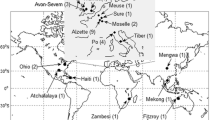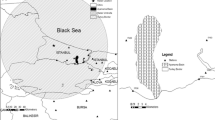Abstract
The next-generation weather radar (NEXRAD) can generally capture the spatial variability of rainfall fields, but fails to provide accurate depth measurements. A systematic strategy to evaluate the accuracy of radar data in depth measurement and its performance in hydrologic model is outlined. Statistical evaluation coefficients are calculated by comparing NEXRAD data with individual raingauges as well as subbasin-averaged interpolations, and point- and surface-average factors are introduced to revise radar data successively. Hydrologic simulations are then performed with a distributed hydrologic model, called basin pollution calculation center (BPCC) with both raingauge observations and revised NEXRAD estimates inputs. The BPCC model is applied to Clear Creek Watershed, IA, USA, on an hourly scale, and the calibration and validation parameters are semi-automatically optimized to improve manual calibration shortcomings. Results show that hydrographs generated from both gauge and NEXRAD are in good agreement with observed flow hydrographs. Coefficient statistics reveal that NEXRAD contributes to model performance, indicating that NEXRAD data has the potential to be used as an alternative source of precipitation data and improve the accuracy of hydrologic simulations.
Similar content being viewed by others
References
Liu Z Y, Tan B Q, Tao X, et al. Application of a distributed hydrologic model to flood forecasting in catchments of different conditions. J Hydrol Eng, 2008, 13(5): 378–384
Getirana A C V, Bonnet M P, Calmant S, et al. Hydrologic monitoring of poorly gauged basins based on rainfall-runoff modeling and spatial altimetry. J Hydrol, 2009, 379: 205–219
Sharif H O, Sparks L, Hassan A A, et al. Application of a Distributed Hydrologic Model to the November 17, 2004, Flood of Bull Creek Watershed, Austin, Texas. J Hydrol Eng, 2010, 15(8): 651–657
Zheng F, Zimmer A, Bedient P B, et al. Using a Distributed Hydrologic Model to Evaluate the Location of Urban Development and Flood Control Storage. J Water Res Pl-ASCE, 2010, 136(5): 597–601
Wang Z G, Zheng H X, Liu C M, et al. A distributed hydrologic model with its application to the Jinghe watershed in the Yellow River Basin. Sci China Set E-Tech Sci, 2004, 47: 60–71
McMillan H, Jackson B, Clark M, et al. Rainfall uncertainty in hydrologic modelling: An evaluation of multiplicative error models. J Hydrol, 2011, 400: 83–94
Kalin L, Hantush M M. Hydrologic modeling of an eastern pennsylvania watershed with NEXRAD and rain gauge data. J Hydrol Eng, 2006, 11(6): 555–569
Collier C G. Applications of Weather Radar Systems: A Guide to Uses of Radar Data in Meteorology. Chichester: Ellis Horwood, 1989
Krajewski W F, Smith J A. Radar hydrology: rainfall estimation. Adv Water Res, 2002, 25: 1387–1394
Ciach G J, Crajewski W F, Gabriele V. Product-error-driven uncertainty model for probabilistic quantitative precipitation estimation with NEXRAD data. J Hydrometeor, 2007, 8(6): 1325–1347
Kalinga O A, Gan T Y. Semi-distributed modeling of basin hydrology with radar and gauged precipitation. Hydrol Process, 2006, 20: 3725–3746
Shi R, Cheng M H, Cui Z H, et al. Estimation amount of summer regional heavy rainfall using the averages of radar VPRs together with rain gauge adjustment (in Chinese). J Appl Meteor Sci, 2005, 16(6): 737–745
Li J T, Yang W S, Guo L, et al. A study of improving precision of measuring regional precipitation in optimum interpolation method (in Chinese). Chin J Atmos Sci, 2000, 24(2): 263–270
Xie H, Zhou X, Vivoni E R, Hendrickx J M H, et al. GIS-based NEXRAD Stage III precipitation database: automated approaches for data processing and visualization. Comput Geosci-UK, 2005, 31: 65–76
Hardegree S P, Van Vactor S S, Levinson D H, et al. Evaluation of NEXRAD radar precipitation products for natural resource applications. Rangeland Ecol Manag, 2008, 61: 346–353
Krajewski W F, Kruger A, Smith J A, et al. Towards better utilization of NEXRAD data in hydrology: an overview of Hydro-NEXRAD. World Environmental and Water Resources Congress: Restoring Our Natural Habitat, 2007
Burlando P. Multi-sensor precipitation measurements integration, calibration and flood forecasting (MUSIC), 2001. http://www.geomin.unibo.it/hydro/music/index2.htm
Bedient P B, Hoblit B C, Gladwell D C, et al. NEXRAD radar for flood prediction in Houston. J Hydrol Eng, 2000, 5(3): 269–277
Bedient P B, Anthony H, Benavides J A, et al. Radar-based flood warning system applied to Tropical Storm Allison. J Hydrol Eng, 2003, 8(6): 308–318
Jayakrishnan R, Srinivasan R, Santhi C, et al. Advances in the application of the SWAT model for water resources management. Hydrol Process, 2005, 19: 749–762
Luzioa M D, Arnold J G. Formulation of a hybird calibration approach for a physically based didtributed model with NEXRAD data input. J Hydrol, 2004, 298: 136–154
Neary V S, Asce M, Habib E, et al. Hydrologic modeling with NEXRAD precipitation in middle Tennessee. J Hydrol Eng, 2004, 9(5): 339–349
Zhang H L, Li D X, Wang X K. Distributed hydrologic and sediment erosion model with its application to Zhengjiangguan watershed in Minjiang river basin (in Chinese). J Hydrodyn, 2011, 26(1): 1–10
Xie H, Zhou J, Hendrickx E, et al. Comparison of NEXRAD stage III and gauge precipitation estimates in central New Mexico. J Am Water Resour As, 2006, 42: 237–256
Young C B, Brunsell N A. Evaluating NEXRAD estimates for the Missouri River Basin: analysis using daily raingauge data. J Hydrol Eng, 2008, 13: 549–553
Zhang X S, Srinivasan R. GIS-based spatial precipitation estimation using next generation radar and raingauge data. Environ Modell Softw, 2010, 25: 1781–1788
Wei Y, Chen M Q, Li Y. A research on improving the weighted method with direction distance (in Chinese). Acta Petrol Sinica, 1998, 4: 89–93
Xu J J, Cai Z G, Liu Z W, et al. Flood forecasting in the Three-Gorge reach based on a distributed hydrologic model (II): application of radar rainfall data (in Chinese). J China Hydrol, 2008, 28(2): 18–22
Zhang C. Distributed Non-point Sources Pollution Modeling and Its Application in Xiangxi Watershed (in Chinese). Dissertation of Doctoral Degree. Beijing: Tsinghua University, 2008
Li W J. Research and Application of Physically Based Water Erosion and Sediment Yield Model (in Chinese). Dissertation of Doctoral Degree. Beijing: Tsinghua University, 2011
Zhang H L. A Distributed Hydrologic Model Coupled with Soil Erosion and Its Application in River Basins (in Chinese). Dissertation of Doctoral Degree. Beijing: Tsinghua University, 2011
Todini E, Ferraresi M. Influence of parameter estimation uncertainty in Kriging. J Hydrol, 1996, 175: 555–566
Allard D. Geostatistical classification and class Kriging. J Geograp Inform Decis Analys (GIDA), 1998, 2(2): 77–90
Nalder I A, Wein R W. Spatial interpolation of climatic normals: test of a new method in the Canadian boreal forest. Agr Forest Meteorol, 1998, 92: 211–225
Horsburgh J S, Tsarboton D G. ODM data loader functional specifications. CUAHSI HIS online report, 2008, http://his.cuahsi.org/odmdatabases.html
Author information
Authors and Affiliations
Corresponding author
Rights and permissions
About this article
Cite this article
Zhang, H., Li, D., Wang, X. et al. Quantitative evaluation of NEXRAD data and its application to the distributed hydrologic model BPCC. Sci. China Technol. Sci. 55, 2617–2624 (2012). https://doi.org/10.1007/s11431-012-4918-2
Received:
Accepted:
Published:
Issue Date:
DOI: https://doi.org/10.1007/s11431-012-4918-2




